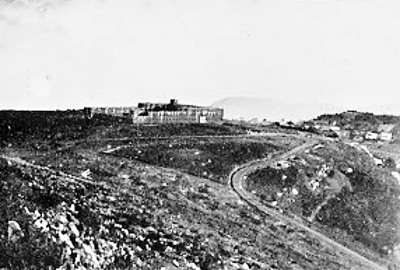Pages in Section 14

The Evacuation of Safad
ii. Evacuation - Hebron
iii. Bassa
iv. Safad
v. Tiberias
vi. Haifa
vii. Jaffa
viii The Last Day
Stand down
Although Safad was a Jewish Holy city, by 1947, it had only 1,700 Jewish residents as opposed to 12000 Arabs. Most of the Jewish residents were religious and elderly. Nevertheless, Safad was included in the area allocated for the proposed Jewish state under the United Nations Partition Plan.
Safad had two police stations, the town centre one and the tegart on the hill above. I am not sure when the Irish Guards took over from the town police but it before Paddy's Day. We know this because the British Police at the tegart were asked to man the town police station for a day so the Irish Guards could go out and honour their favourite saint in traditional style.
 On April 16th 1948, the British Police evacuated the tegart in Safad. The manner of their leaving without an organised hand over seems typical of British evacuation from police stations in Jewish-allocated areas with large Arab majorities. the following is a description of the evacuation by James Wood
On April 16th 1948, the British Police evacuated the tegart in Safad. The manner of their leaving without an organised hand over seems typical of British evacuation from police stations in Jewish-allocated areas with large Arab majorities. the following is a description of the evacuation by James Wood
My room mates and I were very surprised to be visited one night by the Station Commander (Divisional Superintendent?) It was a hush-hush, clandestine visit that he was making to everyone. We were instructed that we would be leaving the next day but no one was to know. We were to carry on completely as normal until the order was given to go. At that point we were to go to the armoury which had to be completely cleared of all weapons and ammunition and carry away whatever we were given . We were then to mount military trucks that would be in the yard ready to evacuate us via the back gates. Our departure would be protected by the Irish Guards and 21st Lancers from Tiberias. Our kit boxes and all our kit was to be left in our rooms.
The order came just as we sat down to our dinner which was left steaming on the dining tables. We left 38 horses with all the saddlery in the stables and an armoured car in the workshops. I did, however, manage to smuggle out my HMV gramophone and records. A very tall constable, who was at least 6' 6", used to be regularly employed at the reception desk inside the front doors above which was a wall clock. He had promised himself that clock would go with him and it did, despite the fact that he was in the shower when the whistle went.
The front doors of the tegart were protected with steel shutters on the outside that slammed shut at the press of button and had to be wound back open with a large detachable metal handle, rather like lock gates. It soon became apparent that someone had a handle and some inside knowledge because we could hear small arms fire inside the front of the building even before we had left by the back.
My lasting memory of driving out of Safad is of an Arab constable running behind our truck with his pitiful personal kit, including a pair of shoes in his hand, begging to be taken with us. To no avail of course.
We were taken in convoy, direct to Nazareth where the weapons were checked into their armoury before we continued on to the depot at Jenin which was being used as a transit camp.
There are conflicting stories of who immediately moved into the tegart and why there was firing at the front of the building while the British PPs were leaving from the back.
After the Palestine Police left 200 local Arab militiamen, supported by over 200 Arab Liberation Army soldiers, tried to take over the city's Jewish Quarter. They were repelled by 200 Haganah fighters, both men and women, boosted by a Palmach platoon.